当前位置:网站首页>Briefly talk about the identification protocol of mobile port -bc1.2
Briefly talk about the identification protocol of mobile port -bc1.2
2022-07-05 08:10:00 【Learning notes of hardware Xiaobai】
About BC1.2 agreement Every engineer engaged in mobile phone hardware design should be very familiar with , It is mainly for the identification of charging port . However, about this part of the agreement , There are many explanations on the Internet , Someone said it very carefully , There are also very rough , Xiaobian is also to learn this part of the agreement , Read a lot of information , Finally, I decided to combine what I learned with what I really encountered at work to make some simple descriptions and explanations .
First of all, we need to know a few nouns
SDP:Standard Downstream Port Standard downlink port , For example, the computer USB mouth . The charging capacity of this port is 0.5A
CDP:Charging Downstream Port With strong charging capacity USB mouth , For example, the computer USB mouth . The charging capacity of this port is average 1.5A.
DCP: Dedicate Charging Port Special charging port , Like mobile phone chargers
PD:portable Device Portable devices , Such as mobile phone .
————————————————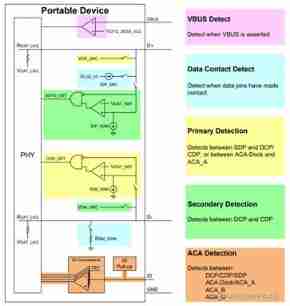 The figure shows the framework of charging port detection
The figure shows the framework of charging port detection
The identification of charging port is mainly divided into the following five steps :
(1)VBUS Detect
(2)Data Contact Detect
(3)Primary Detection
(4)Secondary Detection
(5)ACA Detection
This article mainly talks about the first four common stages
VBUS testing
stay BC1.2 Before the start , First of all, it will be done VBUS Detection of . every last PD There is an in-phase comparator inside , Used to detect VBUS. When the adapter is connected PD when , Only the comparator VBUS Greater than the reference voltage VOTG_SESS_VLD when ,VBUS It will work , The following operations will be carried out . Additional explanation : Because the mobile port USB The design of the seat ( The arrow points to VBUS Pin ),TYPE C Terminal VBUS The pin first touches the mobile phone ( remove GND End ), Next is the data pin contact . This is why the charging identification process , The first thing to do is VBUS detect 了 .
Additional explanation : Because the mobile port USB The design of the seat ( The arrow points to VBUS Pin ),TYPE C Terminal VBUS The pin first touches the mobile phone ( remove GND End ), Next is the data pin contact . This is why the charging identification process , The first thing to do is VBUS detect 了 .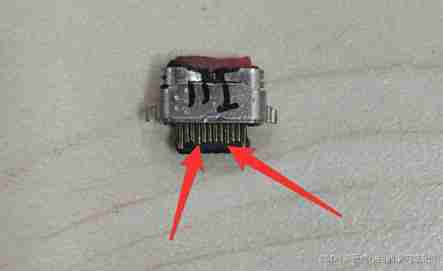
DCD testing
Data Contact Detect, Data connection line detection , That is, judge whether the adapter is fully connected to the mobile phone USB Transposon .
End of judgment VBUS After access , Then it is to judge whether the connection of data signals is in place .
When Attached when
Mobile phone terminal D+ Of IDP_SRC open , because D+ A resistor is terminated RDP_DWN Go down to the ground , therefore D+ There will be a certain small voltage , When the voltage is less than the reference value , explain USB Good access . So look at the waveform D+ There is a very small voltage fluctuation at the front end .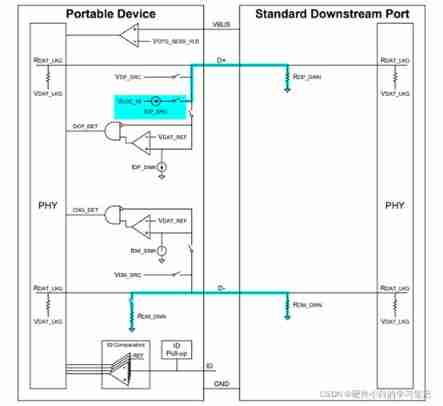
However DCD The detection of is not necessary , If not implemented DCD Detection of , The agreement will be in VBUS Effective T DCD_TIMEOUT Start the next steps ( The following waveform is not executed DCD Detection ).Charging port detection
(1) Primary Detection : distinguish SDP And DCP CDP
When PD Connect to SDP when ,PD The device will open the upper VDP_SRC With the middle IDM_SINK, the D+ There is a certain voltage ( Probably 0.6V), That is, the graphic waveform D+ stay “Primary detection” The higher part in . Then the mobile phone starts to detect D- The voltage of , When D- The voltage is less than VDAT_REF It is thought that what is recognized is SDP. When D- The voltage is greater than VDAT_REF, It is thought that what is recognized is DCP perhaps CDP, Then start the secondary detection .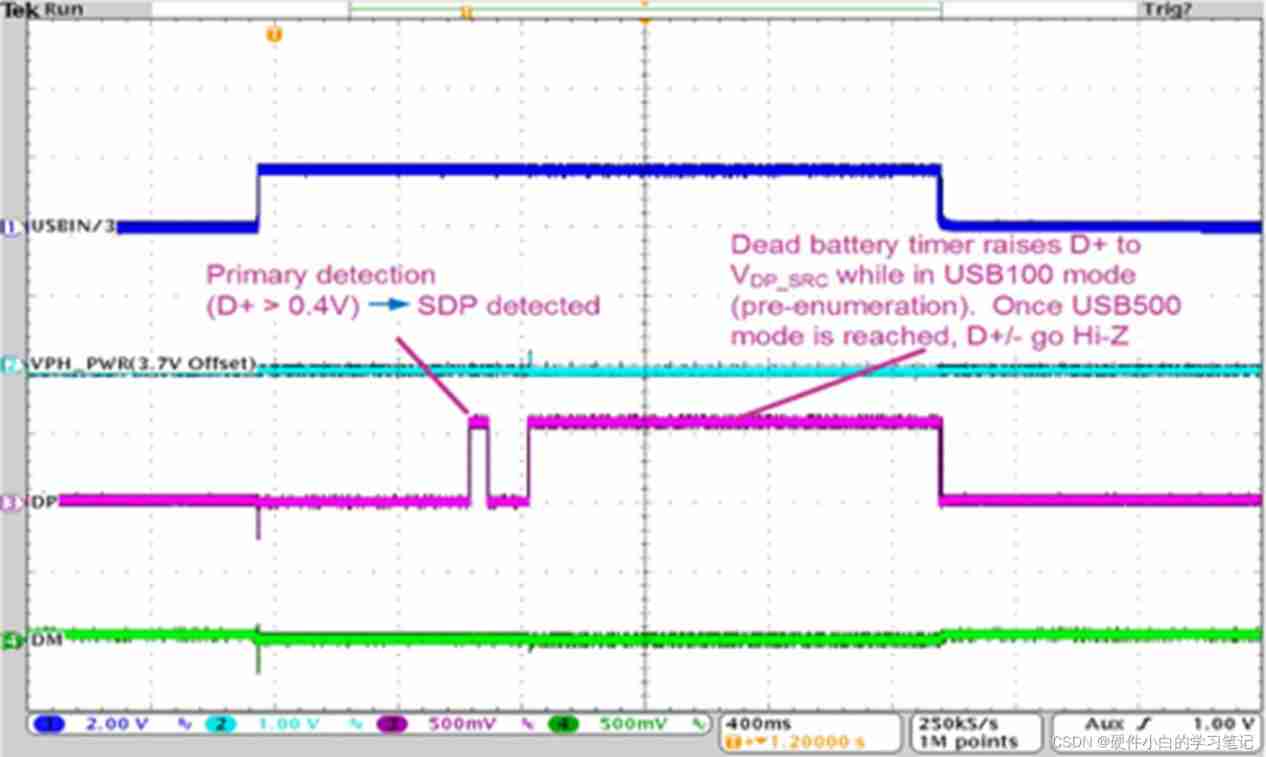 SDP
SDP
(2)Secondary Detection: distinguish DCP And CDP
CDP
After the first test ,PD Will be in D- End open VDM_SRC, stay D+ End open IDP_SINK, At the same time, compare D+ The voltage at the terminal is the same as VDAT_REF, If it is less than VDAT_REF. It indicates that the connected device belongs to CDP.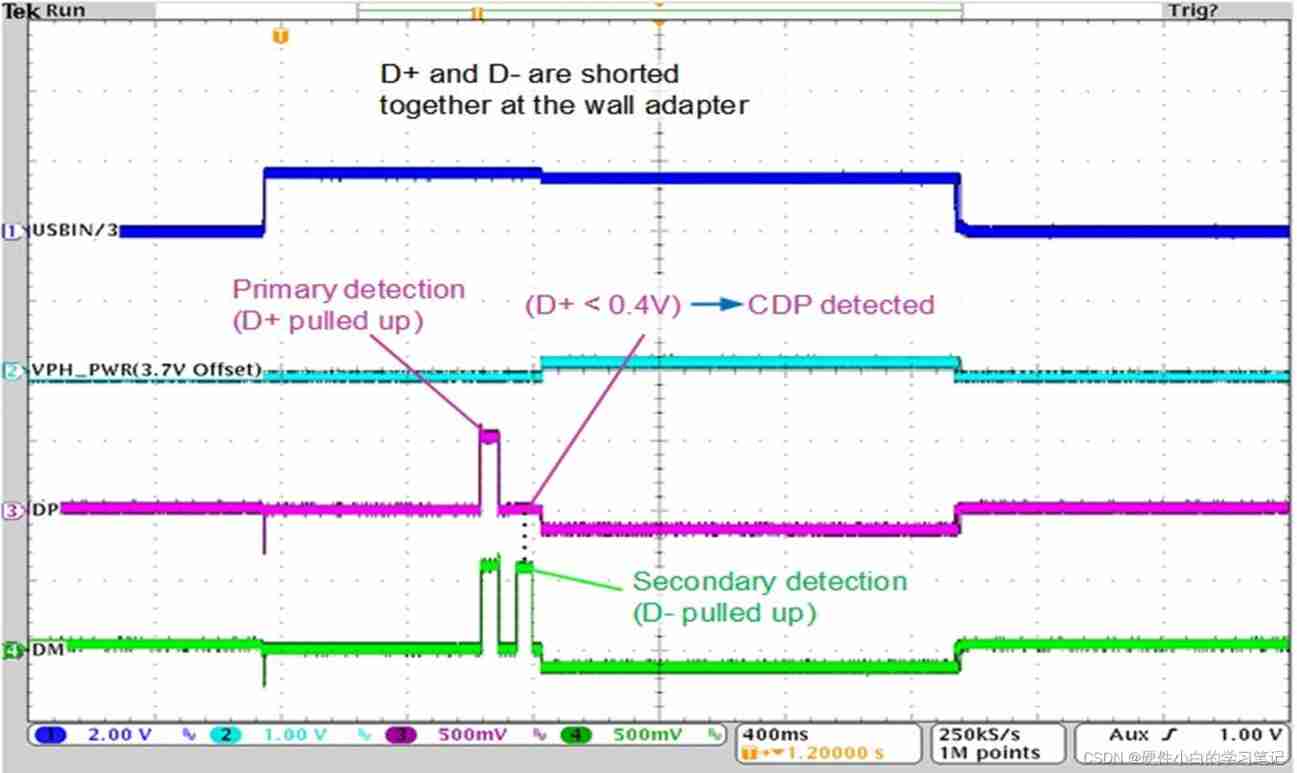
DCP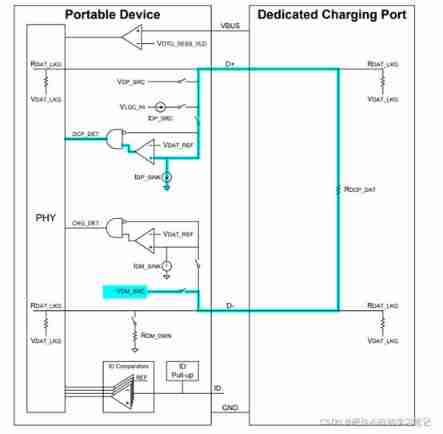
if D+ The voltage at the terminal is greater than VDAT_REF, It shows that the access is DCP, because D+ And D- Through between RDCP_DAT Short circuited together . therefore D+ And D- The voltage is almost similar .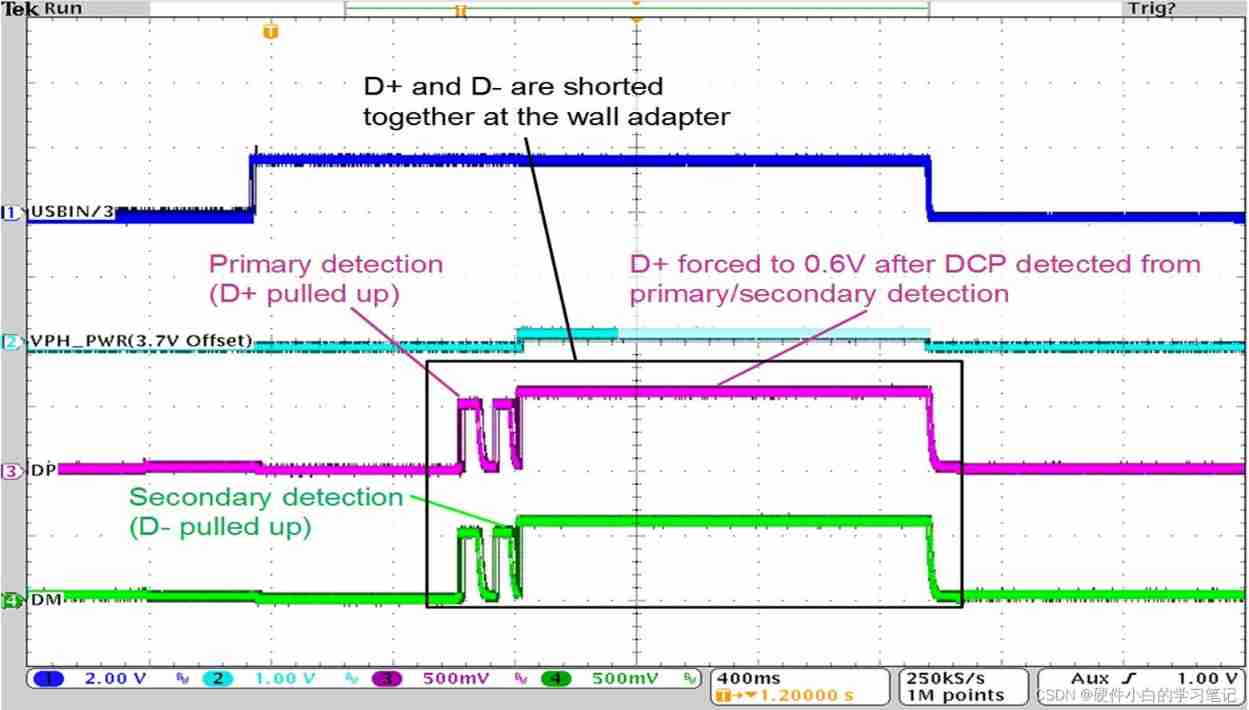
stay DCP After the test , We also need to check whether the protocol supports QC2.0. It will be in D+ End application 0.6V voltage , because DCP Stage ,D+ And D- Short circuited together , therefore D+ And D- The voltage is always the same . Is maintaining 1.25s after D+ And D- Will disconnect the short circuit , if D- The voltage drops to 0V And for a while , Description this adapter supports QC2.0.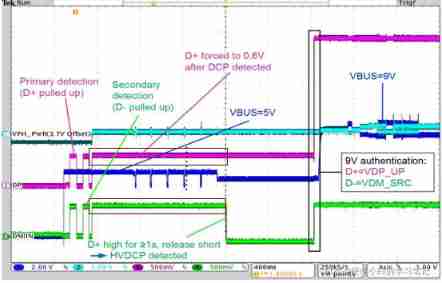
stay D- Fall to 0V And maintain it for a period of time ,D+ And D- The voltage continues to change , This is the picture D+ D- The last stage , It follows the following principles , Inform the charger , Output the corresponding voltage .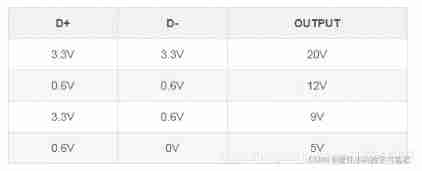
The waveform in the above figure :D+ Final 3.3V,D- Final 0.6V therefore VBUS Be raised to 9V.
All in all , Summarize according to the waveform , In the identification phase ,Primary Detect from D+ launch ,Secondary Detect from D- launch .SDP DCP CDP The difference between the three in waveform ,SDP stay Primary Detect Is recognized , All are located only once D+ High level of .DCP because D+ D- Short circuited by resistance , therefore D+ And D- Always maintain the same level , Both are in the high-level state .CDP It is seen as the waveform neutralization of the two ,D+ There is only one high level ,D- There are two high levels .
边栏推荐
- Use indent to format code
- Soem EtherCAT source code analysis II (list of known configuration information)
- After installing the new version of keil5 or upgrading the JLINK firmware, you will always be prompted about the firmware update
- How to define guid in AMI code
- Fundamentals of C language
- Network communication process
- Several important parameters of LDO circuit design and type selection
- Extern keyword function
- C, Numerical Recipes in C, solution of linear algebraic equations, LU decomposition source program
- C WinForm [realize the previous and next selection pictures] - practice 7
猜你喜欢

Markdown tips

C # joint configuration with Halcon
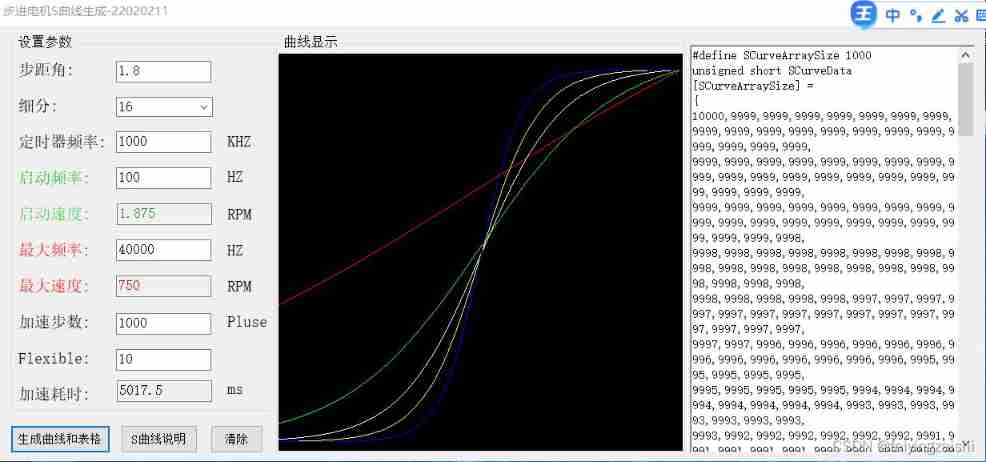
Step motor generates S-curve upper computer
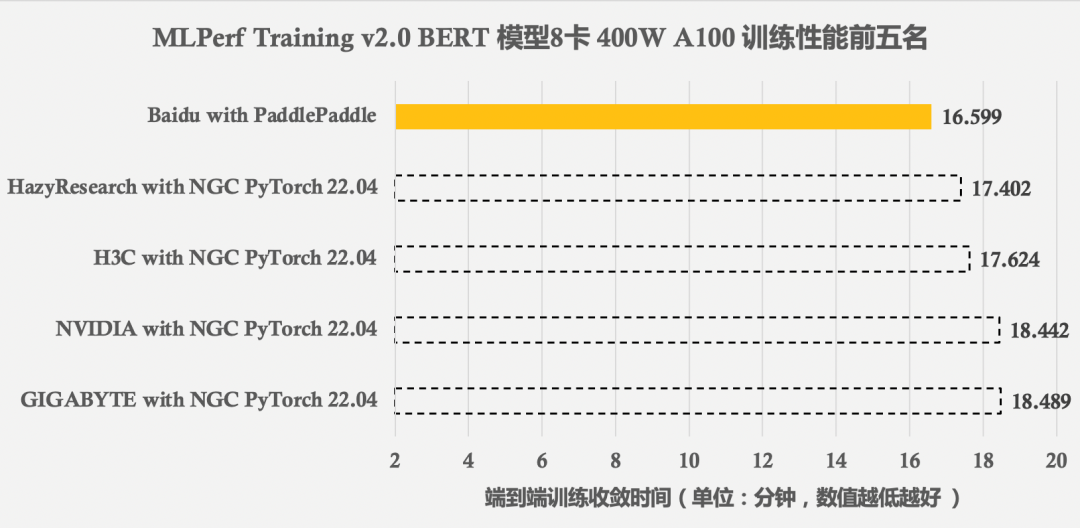
Mlperf training v2.0 list released, with the same GPU configuration, the performance of Baidu PaddlePaddle ranks first in the world
![[untitled] record the visual shock of the Winter Olympics and the introduction of the display screen](/img/43/7f8becc09c5ce7fe401bed140608f3.jpg)
[untitled] record the visual shock of the Winter Olympics and the introduction of the display screen
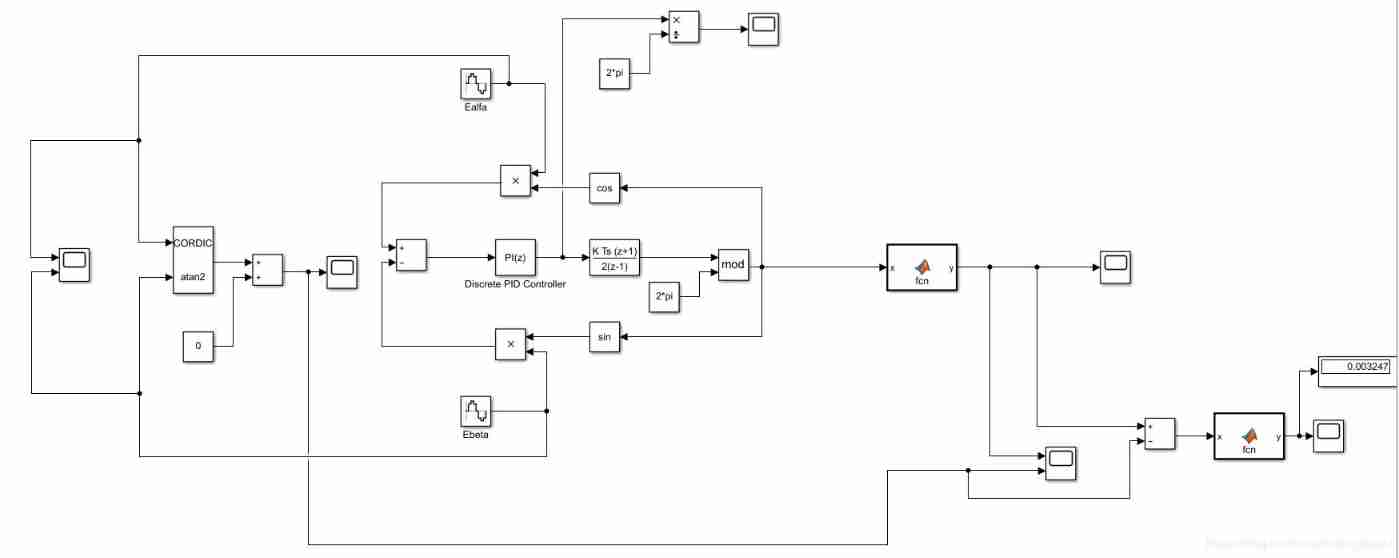
Some thoughts on extracting perspectives from ealfa and Ebeta
![Shape template matching based on Halcon learning [VII] reuse_ model. Hdev routine](/img/55/0f05291755dc1c3c03db8e991a1ba1.jpg)
Shape template matching based on Halcon learning [VII] reuse_ model. Hdev routine
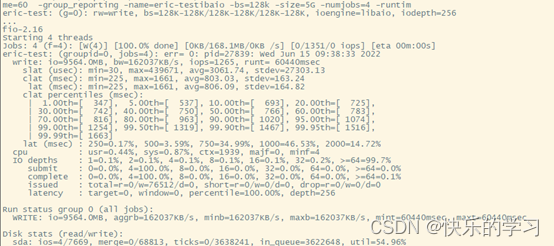
FIO测试硬盘性能参数和实例详细总结(附源码)
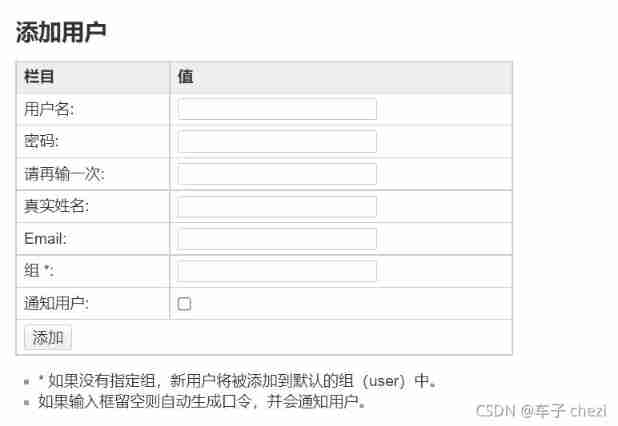
Management and use of DokuWiki

Network port usage
随机推荐
研究发现,跨境电商客服系统都有这五点功能!
C WinForm [get file path -- traverse folder pictures] - practical exercise 6
Can't find real-time chat software? Recommend to you what e-commerce enterprises are using!
Management and use of DokuWiki (supplementary)
Record the torch encountered by win10 cuda. is_ False problem in available()
Hardware 1 -- relationship between gain and magnification
Solutions to compilation warnings in Quartus II
Development tools -- gcc compiler usage
More than 90% of hardware engineers will encounter problems when MOS tubes are burned out!
Introduction of air gap, etc
My-basic application 1: introduction to my-basic parser
Shape template matching based on Halcon learning [VII] reuse_ model. Hdev routine
The research found that the cross-border e-commerce customer service system has these five functions!
Screen record of the opening ceremony of the Beijing winter olympics 2
Markdown tips
The firmware of the connected j-link does not support the following memory access
[untitled] record the visual shock of the Winter Olympics and the introduction of the display screen
Slist of linked list
STM32 tutorial triple ADC interleaved sampling
C WinForm [change the position of the form after running] - Practical Exercise 4